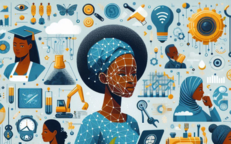Leveraging Smart Technologies To Enhance Access To Reproductive Health Care Services In Africa
This is the 15th post in a blog series to be published in 2023 by the APET Secretariat on behalf of the AU High-Level Panel on Emerging Technologies (APET) and the Calestous Juma Executive Dialogues (CJED)
Approximately 20% of births in the world occur in Africa.[1] Unfortunately, nearly half of all maternal deaths related to pregnancy or childbirth occur in Africa. These disturbing statistics can be attributed to a number of factors including inadequate reproductive healthcare services, which impact 32% of women of reproductive age.[2] Access to comprehensive reproductive healthcare services in African countries is important as it empowers women and couples to make informed decisions regarding family planning, ensuring safe childbirth, and the birth of healthy children. Furthermore, it plays a vital role in promoting sexually healthy lifestyles and preventing sexually transmitted diseases.[3] To realise a vision of Africa where development is people-driven and people-centred, Agenda 2063 includes a plan that emphasises the need of investing in women and young people including improving reproductive health.[4] The African Union's (AU) Agenda 2063 serves as a comprehensive roadmap for Africa's development in the next five decades, with a particular focus on investing in women and young people and addressing sexual reproductive health concerns.
Complementing this initiative is the Addis Ababa Declaration on Population and Development in Africa Beyond 2014, a policy document endorsed by African leaders in 2014. It reaffirms the commitment of African countries to promoting sexual and reproductive health and rights while urging increased investment in these areas. Additionally, the Maputo Protocol, a human rights treaty adopted by African countries in 2003, stands as a significant milestone. It guarantees the sexual and reproductive health and rights of women and girls, aiming to eradicate all forms of discrimination against women.[5]
Furthermore, the AU Roadmap on Harnessing the Demographic Dividend Through Investments in Youth, endorsed by the AU in 2017, lays out a strategic approach for investing in young people to maximise their potential and capitalise on the demographic dividend.[6] These policies collectively underscore the criticality of investing in women and young people, and provide a comprehensive framework for action. By directing resources and efforts towards these groups, African countries can achieve their development goals and foster a brighter future for all.[7]
Africa's progress in sexual and reproductive health and rights has been significant. These advances can be attributed to various factors, such as improved access to contraception, education, and healthcare services. However, there are still challenges that need to be addressed. Africa currently grapples with the highest adolescent fertility rate worldwide and continues to combat the pervasive issue of child marriage in many countries.[8] There exists a decline in access to reproductive health services in Africa can be attributed to harmful cultural beliefs and practices, gender inequality, stigma, and a lack of information. Practices like female genital mutilation (FGM) pose significant risks to women's health, including infections and childbirth complications.
Gender inequality limits women's access to education and healthcare, thereby hindering their ability to obtain necessary reproductive health services. The stigma surrounding reproductive health issues discourages women from seeking testing and treatment.[9] Additionally, the lack of accurate information about sexual and reproductive health contributes to uninformed decision-making. These factors collectively contribute to the declining of women accessing reproductive health services, thereby underscoring the need for countries to continue addressing these issues for the betterment of women and girls in Africa. Nevertheless, the progress achieved thus far is noteworthy. With sustained investment and dedicated effort, Africa has the potential for even greater advancements in sexual and reproductive health and rights. By promoting education, advocacy, and policy changes, African countries can improve reproductive health outcomes and create a healthier future for all.[10]
The African Union High-Level Panel on Emerging Technologies (APET) encourages African countries to leverage emerging technologies to enhance the delivery of reproductive healthcare services on the continent. Smart technologies can be used to improve access to reproductive healthcare services by providing remote healthcare services, tracking, and monitoring health data, delivering educational materials, and promoting advocacy and policy change. APET opines that smart technologies can provide remote healthcare services to people in rural areas and those who cannot easily access healthcare facilities. For example, this can be accomplished through telehealth, which allows patients to consult with doctors and other healthcare providers over the Internet.
Telehealth has the potential to transform reproductive healthcare in Africa, making it more accessible and affordable. Through telehealth, various aspects of reproductive healthcare can be improved. For instance, remote consultations enable individuals in rural areas or with limited access to healthcare to connect with doctors and healthcare providers. Virtual education can provide essential information about sexual and reproductive health to those who lack traditional educational opportunities. Telehealth can also aid in monitoring and treating individuals with reproductive health conditions, ensuring regular check-ups and management of chronic conditions.[11] Telehealth presents numerous opportunities to enhance reproductive healthcare in Africa. It can reach underserved rural populations, reduce healthcare costs, and improve the quality of care by connecting patients with specialised experts.[12]
Already, telehealth initiatives like M-TIBA in Kenya, Imara Health in South Africa, and LifeMD in Nigeria, are utilising telehealth technologies to provide reproductive healthcare services.[13] M-TIBA connects patients in rural areas with doctors and healthcare providers using mobile phones.[14] Imara Health uses video conferencing to connect HIV-positive women with healthcare providers. LifeMD combines video conferencing, phone calls, and messaging to provide reproductive healthcare services to women trying to conceive.[15] Based on these examples, APET asserts that as telehealth continues to evolve, African innovators should pursue more innovative approaches that will further enhance the health and well-being of women and girls throughout the continent.

Figure 1: South Africa’s Imara Telemed platform[16]
APET also recognises the potential of smart technologies in tracking and monitoring health data, particularly in the context of reproductive health in Africa. Smart technologies, such as mobile apps and wearable devices, can be utilised to track menstrual cycles, provide contraception reminders, and connect individuals with healthcare providers. This data can identify individuals at risk of reproductive health problems such as unintended pregnancies or sexually transmitted infections (STIs) and enable timely interventions. Additionally, wearable devices can monitor various health indicators such as heart rate, sleep patterns, and activity levels, helping to identify risks associated with conditions such as pre-eclampsia or gestational diabetes.
Remote patient monitoring (RPM) using technology, such as mobile apps and wearable devices, allows for the tracking and monitoring of patients’ health data from a distance. RPM can identify individuals at risk of reproductive health issues like preterm birth or postpartum depression, facilitating appropriate care and support.[17] These smart technology approaches have the potential to improve health outcomes, particularly in regions with limited access to regular healthcare. They can also contribute to cost reduction by aiding in the identification and treatment of at-risk individuals, resulting in savings for individuals and healthcare systems. Moreover, smart technologies can enhance healthcare accessibility by overcoming geographical barriers, particularly benefiting women and girls who often face obstacles in accessing healthcare.
Ultimately, smart technologies can improve the quality of care by providing comprehensive patient data to healthcare providers, enabling informed decision-making and personalised healthcare. As such, APET appreciates that smart technologies have the potential to revolutionise reproductive health in Africa. By making it easier to track and monitor health data, these technologies can help to identify people who are at risk of developing health problems and to provide them with the care they need. This can lead to improved health outcomes, reduced costs, and increased access to healthcare for women and girls across the continent.[18]
Smart technologies also offer opportunities to deliver educational materials about reproductive health in Africa. Mobile apps serve as convenient platforms to provide information on contraception, sexually transmitted infections (STIs), and other reproductive health topics. They can also offer resources for individuals seeking assistance. Websites, accessible through any device with an internet connection, can deliver educational materials, particularly benefiting people in rural areas. These platforms can provide interactive tools such as quizzes and calculators. Additionally, online platforms such as social media and forums serve as channels to connect individuals, share information, and offer access to educational materials that may not be readily available otherwise.[19]
Implementing smart technologies to deliver educational materials about reproductive health in Africa yields several impacts and opportunities. Firstly, it improves access to information, reaching individuals in remote or underserved areas. Secondly, it increases awareness by making reproductive health information more accessible and engaging. Thirdly, it empowers individuals to make informed decisions about their reproductive health by providing the necessary knowledge. Lastly, it reduces the stigma associated with reproductive health topics by offering a safe and anonymous space for learning.[20]
However, to fully leverage the benefits of using smart technologies for delivering educational materials on reproductive health in Africa, several challenges need to be addressed. The digital divide remains a significant hurdle as not everyone has internet access or smartphones. Lack of awareness about the advantages of using smart technologies poses another challenge, hindering their adoption. Cultural barriers can also impede access to educational materials as some societies may be uncomfortable discussing reproductive health openly. Despite these challenges, maximising the potential of smart technologies in addressing these issues can greatly contribute to improving the reproductive health of women and girls throughout the continent.[21]
Smart technologies are currently employed to deliver educational materials about reproductive health in Africa. For example, in Kenya, Amref Health Africa utilises mobile apps to provide reproductive health educational materials to women and girls. The app covers contraception, STIs, and other relevant topics while offering resources for those seeking assistance. Additionally, Marie Stopes International in South Africa employs a website to deliver educational materials on reproductive health.[22] The website covers contraception, STIs, and other reproductive health subjects while providing resources for those in need. In Nigeria, the Women's Health and Education Programme (WHEP) uses social media platforms such as Facebook and Twitter to deliver educational materials on reproductive health. By connecting with individuals through these platforms, WHEP shares vital information about reproductive health.
Smart technologies also have the potential to drive meaningful impact in promoting advocacy and policy change for reproductive health in Africa. Social media campaigns, such as the #NotJustANumber campaign in Nigeria, leverage platforms such as Facebook, Twitter, and Instagram to raise awareness about reproductive health issues and mobilise individuals for policy change. Mobile applications such as MyDawain Kenya provides information and resources, empowering users to advocate for reproductive health rights and engage in campaigns. Online platforms such as "SheDecides" create spaces for collective action, connecting individuals across Africa to share stories and support initiatives promoting reproductive health and rights.[23]
Figure 2: Kenya’s MyDawa mobile application[24]
African countries can also harness the power of artificial intelligence (AI) to analyse health data and identify individuals at risk of developing health issues, leading to improved early detection and treatment.[25] Additionally, blockchain technology can establish a secure and transparent system for storing and sharing health data, enhancing the quality of care while safeguarding patient privacy. Although the utilisation of smart technologies in reproductive health is in its nascent stages, there is tremendous potential for these innovations to enhance healthcare access and improve health outcomes. As these technologies advance, they will increasingly serve as powerful tools in advancing reproductive health in Africa.[26]
In conclusion, APET recognises that challenges, such as the digital divide, limited internet access and low digital literacy in Africa should be addressed to maximise the impact of smart technologies. The panel calls for bridging this gap through promoting digital literacy programmes, expanding internet infrastructure, and making smart technologies more accessible. Furthermore, urges sensitivity to linguistic and cultural differences and tailoring information and resources in local languages. APET furthers urges governments to establish supportive policy and regulatory frameworks that protect digital rights and privacy and encourage the use of smart technologies in reproductive health advocacy.
Featured Bloggers – APET Secretariat
Aggrey Ambali
Justina Dugbazah
Barbara Glover
Bhekani Mbuli
Chifundo Kungade
Nhlawulo Shikwambane
[1] https://www.afro.who.int/health-topics/maternal-health
[2] Onambele, L., Ortega-Leon, W., Guillen-Aguinaga, S., Forjaz, M. J., Yoseph, A., Guillen-Aguinaga, L., Alas-Brun, R., Arnedo-Pena, A., Aguinaga-Ontoso, I., & Guillen-Grima, F. (2022). Maternal Mortality in Africa: Regional Trends (2000-2017). International journal of environmental research and public health, 19(20), 13146. https://doi.org/10.3390/ijerph192013146
[3] https://www.un.org/en/chronicle/article/reproductive-health-african-region-what-has-been-done-improve-situation
[4] https://au.int/sites/default/files/documents/36195-doc-52569_au_strategy_eng_high.pdf
[5] http://backup.thinkteam.co.za/srjc/wp-content/uploads/2019/10/Final-5-year-review-report-of-the-AADPD-EN.pdf
[6] Mwoka, M., Ajayi, A. I., Kibunja, G., Cheruiyot, C., Ouedraogo, R., Juma, K., Igonya, E. K., Opondo, W., Otukpa, E., Kabiru, C., & Ushie, B. A. (2021). Cocreated regional research agenda for evidence-informed policy and advocacy to improve adolescent sexual and reproductive health and rights in sub-Saharan Africa. BMJ global health, 6(4), e005571. https://doi.org/10.1136/bmjgh-2021-005571
[7] https://au.int/sites/default/files/documents/24099-poa_5-_revised_clean.pdf
[8] https://www.unfpa.org/sites/default/files/resource-pdf/383%20AIU3%20Regional_SSA_ENG%2011.19.14%20FINAL_0.pdf
[9] González-Timoneda, A., González-Timoneda, M., Cano Sánchez, A., & Ruiz Ros, V. (2021). Female Genital Mutilation Consequences and Healthcare Received among Migrant Women: A Phenomenological Qualitative Study. International journal of environmental research and public health, 18(13), 7195. https://doi.org/10.3390/ijerph18137195
[10] https://www.unicef.org/mena/media/20671/file/MENA%20Engaging%20Men%20and%20Boys%20-%20FULL%20REPORT.pdf
[11] Chitungo, I., Mhango, M., Mbunge, E., Dzobo, M., Musuka, G., & Dzinamarira, T. (2021). Utility of telemedicine in sub-Saharan Africa during the COVID-19 pandemic. A rapid review. Human behavior and emerging technologies, 3(5), 843–853. https://doi.org/10.1002/hbe2.297
[12] Akintunde, T. Y., Akintunde, O. D., Musa, T. H., Sayibu, M., Tassang, A. E., Reed, L. M., & Chen, S. (2021). Expanding telemedicine to reduce the burden on the healthcare systems and poverty in Africa for a post-coronavirus disease 2019 (COVID-19) pandemic reformation. Global health journal (Amsterdam, Netherlands), 5(3), 128–134. https://doi.org/10.1016/j.glohj.2021.07.006
[13] https://emergingmarkets.today/how-telemedicine-is-transforming-healthcare-in-kenya-nigeria-and-south-africa/
[14] Oyediran KA, Makinde OA, Adelakin O. The Role of Telemedicine in Addressing Access to Sexual and Reproductive Health Services in sub-Saharan Africa during the COVID-19 Pandemic. Afr J Reprod Health. 2020 Jun;24(s1):49-55. doi: 10.29063/ajrh2020/v24i2s.8. PMID: 34077053.
[15] Marhefka, S. L., Turner, D., & Lockhart, E. (2019). Understanding Women's Willingness to Use e-Health for HIV-Related Services: A Novel Application of the Technology Readiness and Acceptance Model to a Highly Stigmatized Medical Condition. Telemedicine journal and e-health: the official journal of the American Telemedicine Association, 25(6), 511–518. https://doi.org/10.1089/tmj.2018.0066
[16] https://www.facebook.com/photo.php?fbid=656709275967575&set=pb.100048855255631.-2207520000.&type=3
[17] Schantz, J. S., Fernandez, C. S. P., & Anne Marie, Z. J. (2021). Menstrual Cycle Tracking Applications and the Potential for Epidemiological Research: A Comprehensive Review of the Literature. Current epidemiology reports, 8(1), 9–19. https://doi.org/10.1007/s40471-020-00260-3
[18] Haleem, A., Javaid, M., Singh, R. P., & Suman, R. (2021). Telemedicine for healthcare: Capabilities, features, barriers, and applications. Sensors international, 2, 100117. https://doi.org/10.1016/j.sintl.2021.100117
[19] Muehlmann, M., Tomczyk, S. Mobile Apps for Sexual and Reproductive Health Education: a Systematic Review and Quality Assessment. Curr Sex Health Rep 15, 77–99 (2023). https://doi.org/10.1007/s11930-023-00359-w
[20] Iacoella F, Gassmann F, Tirivayi N. Which communication technology is effective for promoting reproductive health? Television, radio, and mobile phones in sub-Saharan Africa. PLoS One. 2022 Aug 17;17(8):e0272501. doi: 10.1371/journal.pone.0272501. PMID: 35976900; PMCID: PMC9384982
[21] Faloye, Samuel & Ajayi, Nurudeen. (2021). Understanding the impact of the digital divide on South African students in higher educational institutions. African Journal of Science, Technology, Innovation and Development. 14. 1-11. 10.1080/20421338.2021.1983118.
[22] https://amref.org/making-pregnancy-safe-and-expanding-reproductive-health/
[23] Iacoella F, Gassmann F, Tirivayi N. Which communication technology is effective for promoting reproductive health? Television, radio, and mobile phones in sub-Saharan Africa. PLoS One. 2022 Aug 17;17(8):e0272501. doi: 10.1371/journal.pone.0272501. PMID: 35976900; PMCID: PMC9384982.
[24] https://cioafrica.co/mydawa-sanlam-insurance-partner-to-offer-affordable-healthcare-products/
[25] Owoyemi, A., Owoyemi, J., Osiyemi, A., & Boyd, A. (2020). Artificial Intelligence for Healthcare in Africa. Frontiers in digital health, 2, 6. https://doi.org/10.3389/fdgth.2020.00006
[26] https://revistaidees.cat/en/artificial-intelligence-and-health-technologies-in-africa/


